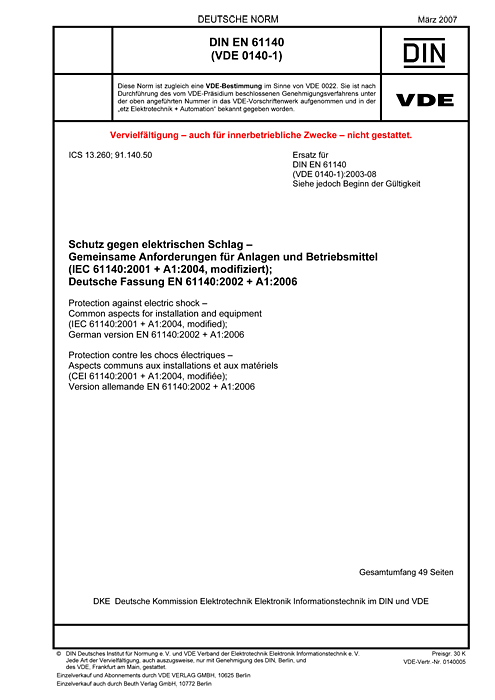-
Iec 61140 Pdf카테고리 없음 2020. 3. 6. 12:53

Iec 61140 Pdf Format
Contents.Class 0 These appliances have no protective-earth connection and feature only a single level of insulation between live parts and exposed metalwork. If permitted at all, Class 0 items are intended for use in dry areas only. A single fault could cause an or other dangerous occurrence, without triggering the automatic operation of any fuse or circuit breaker. Sales of such items have been prohibited in much of the world for safety reasons, for example in the UK by Section 8 of and New Zealand by the. A typical example of a Class 0 appliance is the old style of.
However, equipment of this class is common in some 110 V countries, and in much of the 220 V developing world, whether permitted officially or not. These appliances do not have their chassis connected to electrical earth. In many countries the plug of a class 0 equipment is such that it cannot be inserted to grounded outlet like.
The failure of such an equipment in a location where there are grounded equipment can cause fatal shock if one touches both. Any equipment with a schuko plug will act like a Class 0 equipment when connected to an ungrounded outlet.Class I. Class I symbolThese appliances must have their chassis connected to (US: ground) by a separate conductor ( green/yellow in most countries, green in the US, Canada and Japan).The earth connection is achieved with a 3-conductor mains cable, typically ending with 3-prong which plugs into a corresponding AC outlet. The basic requirement is that no single failure can result in dangerous voltage becoming exposed so that it might cause an electric shock and that if a fault occurs the supply will be removed automatically (this is sometimes referred to as ADS = Automatic Disconnection of Supply).A fault in the appliance which causes a live conductor to contact the casing will cause a current to flow in the earth conductor. If large enough, this current will trip an over-current device ( or (CB)) and disconnect the supply. The disconnection time has to be fast enough not to allow to start if a person is in contact with the casing at the time.
Class II symbolA Class II or double insulated is one which has been designed in such a way that it does not require a safety connection to (ground).The basic requirement is that no single failure can result in dangerous becoming exposed so that it might cause an and that this is achieved without relying on an earthed metal casing. This is usually achieved at least in part by having at least two layers of material between live parts and the user, or by using reinforced insulation.In, a double insulated appliance must be labelled Class II or double insulated or bear the double insulation symbol: ⧈ (a square inside another square).Insulated AC/DC power supplies (such as cell-phone chargers) are typically designated as Class II, meaning that the DC output wires are isolated from the AC input.

The designation 'Class II' should not be confused with the designation 'Class 2', as the latter is unrelated to insulation (it originates from standard UL 1310, setting limits on maximum output voltage/current/power).Class III. Class III symbolA Class III appliance is designed to be supplied from a separated/safety extra-low voltage power source. The voltage from a SELV supply is low enough that under normal conditions a person can safely come into contact with it without risk of electrical shock. The extra safety features built into Class I and Class II appliances are therefore not required. For medical devices, compliance with Class III is not considered sufficient protection, and further more-stringent regulations apply to such equipment.See also.References.
Contents.RegulationsIn most countries, electrical installations shall comply with more than one set of regulations, issued by National Authorities or by recognized private bodies. It is essential to take into account these local constraints before starting the design.These regulations may be based on national standards derived from the IEC 60364: Low-voltage electrical installations.StandardsThis Guide is based on relevant IEC standards, in particular IEC 60364. IEC 60364 has been established by engineering experts of all countries in the world comparing their experience at an international level.
